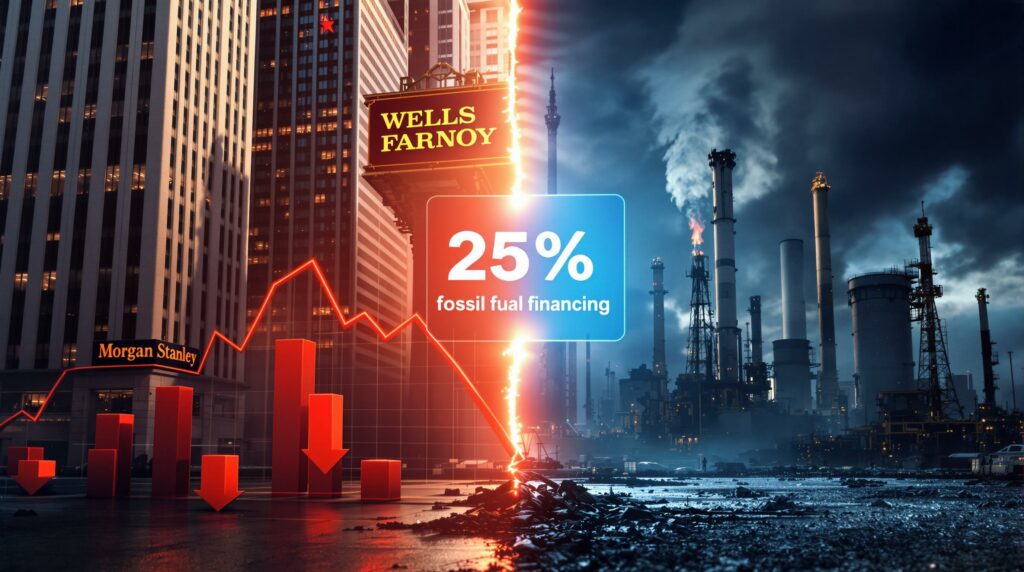The Financial Shift: Wall Street's Retreat from Oil and Gas Financing
In a significant market development, Wall Street's largest banks have dramatically pulled back their financial support for fossil fuel projects in 2025. This retreat marks a turning point in energy sector investment patterns with far-reaching implications for both traditional and renewable energy companies.
The Sharp Decline in Fossil Fuel Funding
The numbers paint a clear picture: Wall Street's six largest banks have significantly reduced their financing for oil, gas, and coal projects this year. According to Bloomberg calculations, funding to the hydrocarbon industry has fallen by 25% compared to the same period last year, with total financing dropping to $73 billion in the first seven months of 2025.
The reduction varies considerably among major financial institutions. Morgan Stanley has implemented the most dramatic pullback, with a 54% decrease in lending to oil, gas, and coal companies compared to last year. Wells Fargo's business with the energy industry declined by 17%, while JP Morgan saw only a 7% decline in lending to oil and gas projects.
This pronounced shift raises important questions about what's driving the retreat from traditional energy investments and what it means for the future of energy financing globally.
What's Behind the Financing Retreat?
The Complex Role of ESG Pressure
All of the banks included in the Bloomberg analysis recently exited the Net-Zero Banking Alliance, suggesting a potential rejection of environmental, social, and governance (ESG) principles. However, the reality is more nuanced than a simple abandonment of climate commitments.
These financial institutions have faced mounting pressure from multiple directions:
- Political pushback: State governments in fossil fuel-producing regions have accused banks of discriminating against traditional energy companies
- Fiduciary concerns: Banks have expressed worries that strict climate commitments might interfere with their responsibility to maximize returns for clients
- Regulatory burden: Reporting requirements and investment restrictions have become increasingly complex and demanding
Despite leaving formal climate alliances, many banks appear to be continuing their transition plans more discreetly. The Net-Zero Banking Alliance itself has evolved, deciding to give its members "flexibility" in meeting their net-zero commitments by dropping a mandate for 1.5-degree alignment, according to Argus Media reporting.
Industry insight: The apparent contradiction between leaving climate alliances while still reducing fossil fuel financing suggests banks are navigating a complex political landscape rather than abandoning transition goals entirely.
Market Conditions Creating Investment Caution
Several market factors appear to be driving the financing decline beyond ESG considerations:
- Oil price volatility: Unpredictable oil prices have prompted energy companies to revise investment plans
- First decline since pandemic: According to JP Morgan analysis, 2025 may mark the first year since 2020 that upstream investment in oil and gas decreases
- Geopolitical uncertainty: Ongoing conflicts and potential policy shifts have encouraged greater caution in capital deployment
JP Morgan analysts noted in their 1Q25 report: "Drawing from data provided by 145 public companies during their 1Q25 earnings results, along with our estimates of private operators' spending, we estimate a 1.1% ($5.9 billion) reduction in global upstream oil and gas development spending, bringing it down to $543 billion, marking the first year-over-year contraction since 2020."
This pullback in investment comes despite physical market indicators suggesting the oil market remains relatively tight rather than oversupplied, according to Reuters analysis from August 2025.
Are Renewable Investments Filling the Gap?
Private Equity Steps Into the Void
Interestingly, the reduction in fossil fuel financing hasn't translated into proportional increases in renewable energy funding from major banks. Instead, alternative investors are seizing the opportunity.
The Financial Times reported in June 2025 that private equity firms were stepping in to finance struggling wind and solar businesses—though at a significant cost. The report identified Apollo, KKR, Blackstone, and Brookfield as the new financial backers of energy transition companies, offering capital under "expensive and restrictive" terms characteristic of private equity deals.
This shift raises questions about why major Wall Street banks have been notably absent from this transition financing opportunity despite their public commitments to supporting clean energy development.
The Renewable Financing Challenge
Several factors make renewable energy financing particularly challenging in the current environment:
- Policy uncertainty: Constant shifts in subsidy programs and tax incentives create unpredictable investment landscapes
- Interest rate sensitivity: Capital-intensive renewable projects are particularly vulnerable to higher financing costs
- Technology evolution risk: Rapid innovation means today's investments could become outdated more quickly
- Market saturation concerns: Oversupply issues in certain renewable sectors have created caution among lenders
Private equity firms appear willing to accept these risks—at premium rates—while traditional banks have become more selective in their renewable investments, focusing primarily on the most established technologies and developers.
What Are the Long-Term Implications?
Supply Concerns on the Horizon
The reduction in oil and gas investment has raised serious questions about future supply adequacy. In a notable development, even the International Energy Agency (IEA) has modified its stance on fossil fuel investments.
After previously advocating for ending new oil and gas investments, the IEA acknowledged at CERAWeek in March 2025 that "there would be a need for investment, especially to address the decline in the existing fields." This represents a significant reversal from their 2021 position, according to Reuters reporting.
OPEC has consistently warned about insufficient investment in new supply, though these concerns have often been dismissed by analysts projecting oversupply due to electric vehicle adoption and other demand-reducing trends.
Market reality check: Despite projections of demand destruction, physical demand and supply data show that the oil market remains quite tight and not in a glut at all, challenging the narrative of inevitable fossil fuel decline.
The Balance of Power Is Shifting
The financing pullback is reshaping the energy landscape in several ways:
- National oil companies rising: State-backed enterprises with access to sovereign funding are gaining competitive advantages
- Private capital's growing influence: Private equity and other alternative investors are becoming more powerful in both traditional and renewable energy sectors
- Consolidation pressure mounting: Smaller players with limited access to capital face increasing acquisition pressure
- Project selectivity intensifying: Only the highest-quality projects with the strongest economics are securing funding
This rebalancing of financial power could have profound implications for which energy projects move forward and which countries maintain energy development momentum in the coming years.
How Are Energy Companies Responding?
Strategic Adaptations to Changing Capital Availability
Energy companies are implementing various strategies to navigate the changing financial landscape:
- Self-funding emphasis: Increasing reliance on internal cash flows rather than external financing
- Portfolio rationalization: Focusing capital on highest-return projects and divesting non-core assets
- Operational efficiency drives: Implementing cost-cutting measures and technological improvements
- Financial structure innovation: Exploring alternative financing structures like joint ventures and project finance
For many energy companies, the focus has shifted to maximizing value from existing assets rather than pursuing aggressive growth strategies that require substantial external financing.
The Cautious Approach to Capital Allocation
The uncertain political and regulatory environment has encouraged a more conservative approach to investment. Companies are increasingly prioritizing:
- Shorter-cycle investments: Projects with faster payback periods face less long-term policy risk
- Operational flexibility: Investments that can be quickly scaled up or down as conditions change
- Regulatory resilience: Assets less vulnerable to potential policy shifts
- Diversification strategies: Balancing traditional and low-carbon investments to hedge against policy changes
This cautious approach, while potentially limiting short-term growth, may ultimately create more sustainable business models in an environment of persistent uncertainty.
What Does This Mean for Energy Transition?
A More Complex Pathway Forward
The reduction in fossil fuel financing doesn't necessarily indicate an acceleration of energy transition. Instead, it suggests a more nuanced and potentially slower transition characterized by:
- Pragmatic incrementalism: Gradual shifts rather than revolutionary change
- Market-driven timing: Economic factors rather than policy mandates driving investment decisions
- Regional divergence: Different transition speeds across various geographies
- Technology-neutral approaches: Focus on emissions reduction rather than specific solutions
The energy transition challenges appear to be evolving into a more complex, economically-driven process rather than following the smooth, policy-directed pathway many had envisioned.
The Investment Gap Challenge
A critical question emerges: if banks are reducing fossil fuel financing without proportionally increasing renewable investments, who will fund the massive capital requirements of energy transition?
The International Energy Agency estimates that achieving net-zero emissions by 2050 requires annual clean energy investment to more than triple to around $4 trillion by 2030. The current financing trends suggest a potential shortfall that could significantly impact transition timelines.
Private equity and other alternative investors are partially filling this gap, but their higher return requirements and shorter investment horizons may not be ideal for all types of energy transition projects.
Navigating the Changing Energy Finance Landscape
Key Considerations for Stakeholders
For investors, policymakers, and industry participants navigating this shifting landscape, several factors merit close attention:
- Policy stability: Consistent regulatory frameworks will be crucial for attracting long-term capital
- Financial innovation: New financing structures may be needed to bridge the investment gap
- Risk assessment evolution: More sophisticated approaches to evaluating energy project risks are emerging
- Strategic partnerships: Collaboration between different types of financial institutions may optimize capital deployment
Expert insight: The most successful energy companies will likely be those that can access diverse capital sources while maintaining the flexibility to adapt to changing market conditions.
Watch for These Signposts
Several indicators will help signal the direction of energy financing in the coming years:
- Bank lending commitments: Any reversal of the current downward trend
- Private equity fundraising: Dedicated energy transition funds and their deployment patterns
- Project finance volumes: Changes in structured financing for energy infrastructure
- Capital expenditure plans: Energy company investment forecasts and their execution
- Policy developments: New incentives or regulations affecting energy investment
Conclusion: A New Era in Energy Finance
The 25% reduction in Wall Street financing for fossil fuels represents a significant shift in energy capital allocation. However, this trend doesn't simply reflect an acceleration of the energy transition but rather a more complex response to market conditions, political uncertainty, and risk management considerations.
For energy companies, investors, and policymakers, this changing financial landscape creates both challenges and opportunities. The most successful participants will likely be those who can navigate uncertainty with flexible strategies while maintaining access to diverse capital sources.
What appears clear is that the energy financing landscape is becoming increasingly nuanced, moving beyond simple binary choices between fossil fuels and renewables toward more complex, economically-driven decision frameworks that balance multiple objectives and timeframes.
As Wall Street cuts oil cash while politics cloud the forecast, the resulting capital reallocation will have profound implications for the pace and direction of global market impact. Furthermore, the combined effects of OPEC production impact and US oil production decline alongside current oil price rally trends will shape global energy development in the years ahead.
Interested in Tracking Critical Mineral Discoveries on the ASX?
Don't miss out on potential investment opportunities as Wall Street shifts away from fossil fuels. Discover significant ASX mineral discoveries in real-time with Discovery Alert's proprietary Discovery IQ model, providing actionable insights for investors seeking market advantages in the evolving energy landscape. Explore historic returns of major mineral discoveries at https://discoveryalert.com.au/discoveries/.




